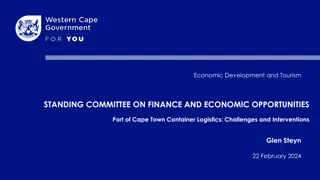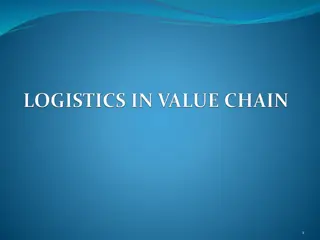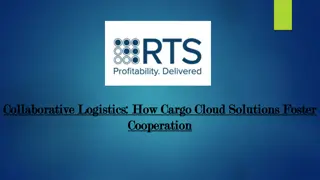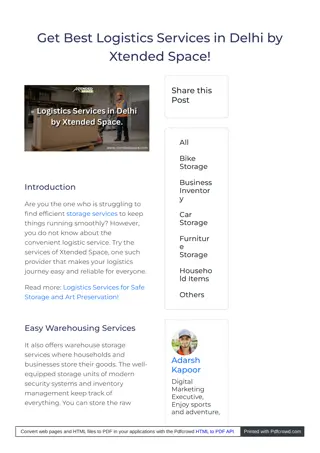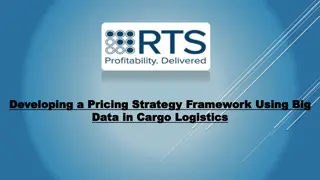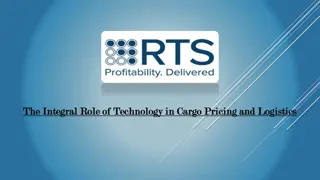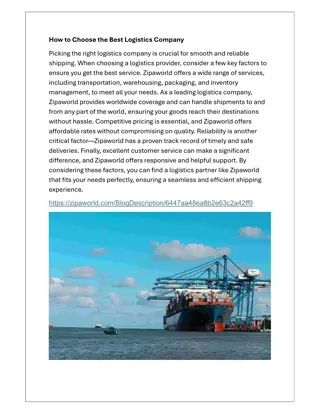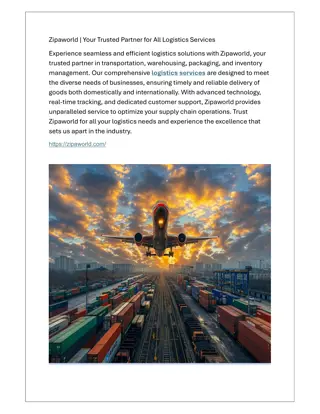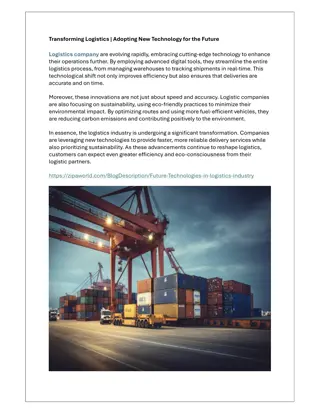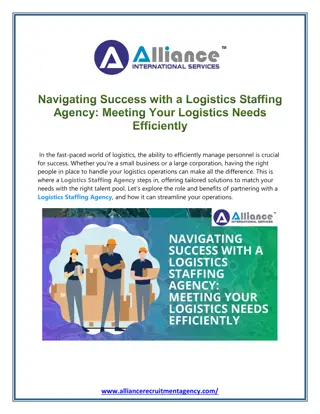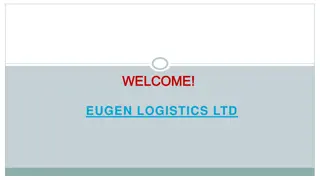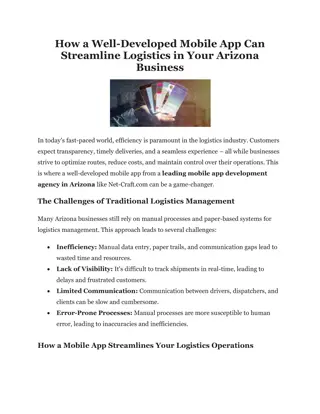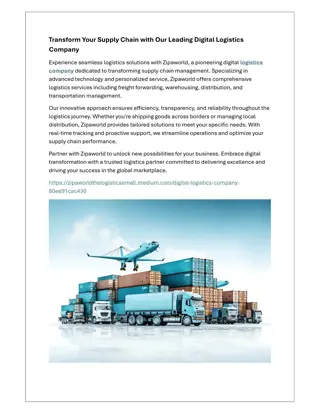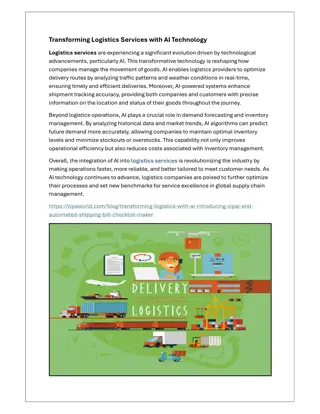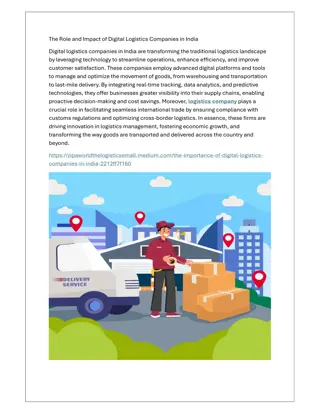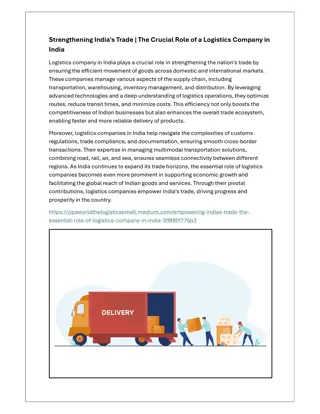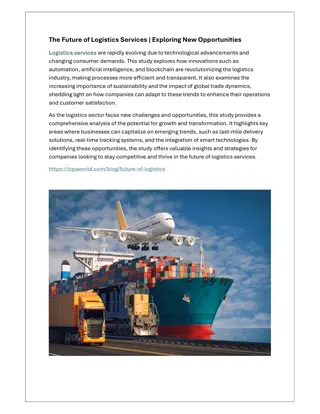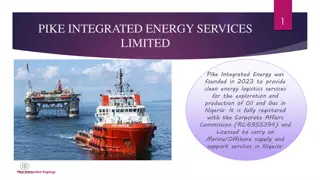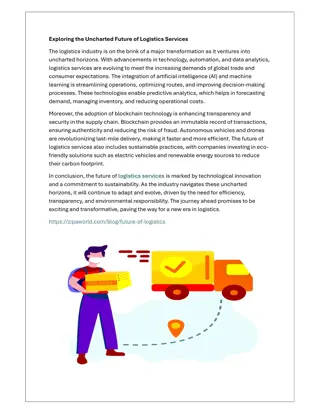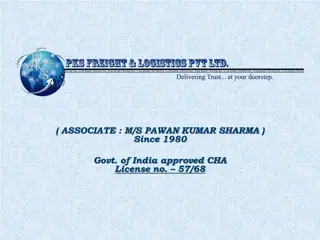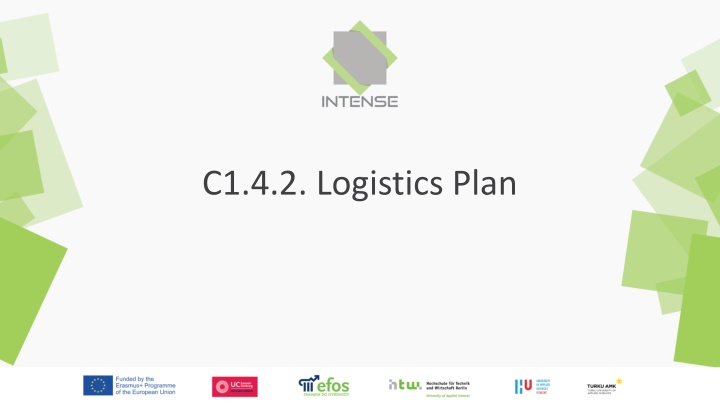
Logistics for International Business: Modes of Transportation and Operations
Explore the fundamental concepts of logistics, including transportation and inventory management, and how they impact various functions within a company. Learn about the marketing mix elements for international companies, advantages and disadvantages of different transportation modes, and the relative performance of each mode. Discover practical skills in supplier sourcing and logistical challenges.
Download Presentation

Please find below an Image/Link to download the presentation.
The content on the website is provided AS IS for your information and personal use only. It may not be sold, licensed, or shared on other websites without obtaining consent from the author. If you encounter any issues during the download, it is possible that the publisher has removed the file from their server.
You are allowed to download the files provided on this website for personal or commercial use, subject to the condition that they are used lawfully. All files are the property of their respective owners.
The content on the website is provided AS IS for your information and personal use only. It may not be sold, licensed, or shared on other websites without obtaining consent from the author.
E N D
Presentation Transcript
Learning Objectives The student can define the basic concepts of logistics (transportation and inventory) and understand the influence of logistics to company s other functions The students train their practical skills related to looking for suppliers from different sources and thinking about the logistical challenges with the chosen suppliers
What is logistics? Includes the major part of: The total flow of materials (finished and unfinished) Information, both: Downstream (processing the materials collected during the upstream stage into a finished product and actual sale) Upstream (searching for and extracting raw materials) Includes activities such as transport, storage, inventory management, materials handling, and order processing "Dieses Foto" von Unbekannter Autor ist lizenziert gem CC BY-NC-ND
The Elements of the Marketing Mix for International Companies BUSINESS STRATEGIES * Differentiation * Cost Leadership * Focus MARKETING MIX PLACE Get products/services into customers hands via transportation PRODUCT PRICING PROMOTION PLACE: Basic questions concerning logistics, how to arrange the transportation and inventory (centralised or near the customer)?
Advantages and Disadvantages of Different Modes of Transportation Transportation Mode Advantages Disadvantages Sample Products Train Safe Reliable Inexpensive Low emissions Limited to rail routes Slow Automobiles Grains Heavy products Chemicals Airplane Safe Reliable Expensive Limited access High emissions Jewelry Medicine Light products Truck Versatile Inexpensive Small size High emissions Consumer goods Ship Inexpensive Good for large products Slow Indirect High emissions Automobile Furniture Bulk products Pipeline Inexpensive Unusable for many products Limited access Gas Oil (Wall&Rees, International Business)
The Relative Performance of Each Mode of Transport Operation s Performance Objective Road Rail Air Water Pipeline Delivery speed 2 2 1 (fastest) 5 4 Delivery dependability 2 3 4 5 1 Quality 2 3 4 5 1 Cost 3 4 5 (most expensive) 2 1 Route flexibility 1 2 3 4 5 (Scale 1-5) (Wall, Rees, 2004)
CO2Emissions Source: ICS 2019 Source: Pyscg Org 2010
Impacts of Transportation Mode Inventory Mode of Transport Order Cycle Packaging Buffer Stock (Wall, Rees, 2004)
Inventory Costs Holding/carrying costs (Wall&Rees, International Business) 3) Stock-out costs 2) Order costs Difficult to quantify a) Stock-out of materials and work-in- progress, may result in machine and operator idle time Possibly overtime payments to catch up on missed production b) Stock-out of finished goods may result in: Missed orders from occasional customers Missed delivery dates Deterioration in customer/supplier relations Penalty clauses incurred for late delivery c) Stock-out of tools and spares may result in an increase in downtime of machinery and loss production Insurance, storage costs (staff, equipment, handling, deterioration, obsolescence, security) Occur when obtaining stock The costs of clerical and administrative work in raising and order, any associated transport costs, inspection of stock on arrival
Stock Carrying/Holding Costs Can be expected to rise as the order size increases Stock ordering costs can be expected to fall as the order size increases If stock-out costs (difficult to quantify) are ignored, we can regard the total (inventory) costs as the sum of carrying and ordering costs EOQ (Economic Order Quantity)
Economic Order Quantity The right order quantity can be optimised as follows: EOQ = 2??0 ? D= annual demand for stock C0= ordering costs for one order Ch = holding costs for one item EOQ minimises total holding and ordering costs for the year Even if all the assumptions don t hold exactly, the EOQ gives a good indication of whether or not current order quantities are reasonable
Reorder Point/Order Level in Warehouse: Number of units of an item on hand, when a purchase order for its replenishment is to be issued (production/sales/year ) lead time + safety stock 365 (Average daily usage rate) Consumption of an item during order lead time
The Importance of Safety Stock The maximum Growth of stock Late Stockout delivery demand Safety stock Time
Short Assignment 1. ABC Ltd. is engaged in the sale of footballs. Its cost per order is 400 euros and its holding cost is 10 euros per unit per annum. The company has a demand for 20,000 units per year. a) What is the EOQ? b) Total number of orders required during a year? c) Total ordering cost for the year?
Short Assignment 2. a) A company needs a product 6000 pieces/year. The delivery time is 5 days. What is the reorder point if you know that the consumption varies a little bit and the company wants to have a safety stock for 2 days? b) What is the reorder point if the delivery time is 20 days and the company wants to have a safety stock for 5 days?
Short Assignment 3. Research information about the different modes of transportation in your own country: Which are the most important ones and what s the reason for this? Is there a difference if you compare importing to your country and exporting from your country? You can also look for information of some other country and compare the results
Centralised versus Decentralised Inventory Centralised Inventory Decentralised Inventory
Iceberg Model Initial Purchase price Transportation costs Visible part Installation User training Operating energy, fuel Repairs and Spare parts Administrative/Purchasing costs Disposal costs etc.
Supply Market Research External factors determine the degree of availability of a certain product, not influenced by individual companies The number of customers or buyers in a market The number of suppliers The market structure (transparency, pricing method) The stock situation of the product in question Speed of technological innovation
Subjects of Supply Market Research Materials, goods, and services Systems and procedures Suppliers Different pricing methods; raw- materials, components etc. New, potential suppliers Existing suppliers with quality problems, etc. Information systems Administrative procedures
Where to find information? Internet sources: www.industrystock.com www.corporateinformation.com www.europages.com www.kompass.com Other sources: Visits to suppliers Catalogues Fairs Magazines Statistics Discussions with other companies or purchasers
Electronic Sources of Supply Market Information (e-marketplaces) Van Weele Industry Automotive E-marketplace www.covisint.com www.supplyon.com Aviation www.aeroxchange.com www.exostar.com Building and construction www.bravosolution.com Chemicals www.elemica.com There are about 1000 e-marketplaces for businesses globally
Electronic Sources of Supply Market Information (e-marketplaces) Industry Food and beverages E-marketplace www.transora.com Healthcare and pharmaceutical www.ghx.com Transportation and logistics www.transcore.com Retail and consumer goods www.globalsources.com
Summary Basic questions concerning logistics: how to arrange the transportation and inventory (centralised or near the customer)? The mode of transport influences: inventory, order cycle, buffer stock, and packaging
Learning Objectives The student can define the basic concepts of logistics (transportation and inventory) and understand the influence of logistics to company s other functions The students train their practical skills related to looking for suppliers from different sources and thinking about the logistical challenges with the chosen suppliers
Self-Study Required reading: Waters, D. & Rinsler, S. (2010). Global Logistics, 7thedition, Kogan Page Ltd, pp. 1-11, 29-47.
Assignment Assignment Logistics Source: Moodle
References Griffin, R., & Pustay, M. (2010). International Business. Pearson Prentice Hall. Ritvanen, V., Inkil inen, A., von Bell, A. & Santala,J. (2011). Logistiikan ja toimitusketjujen hallinnan perusteet. Suomen Huolintaliikkeiden Liitto ry & Suomen Osto- ja Logistiikkayhdistys LOGY ry. Sakki, J. (2009). Tilaus-toimitusketjun hallinta. Jouni Sakki Oy. Wall, S., & Rees, B. (2004). International Business. Pearson Education Limited. Van Weele, A. (2014). Purchasing and supply chain management. Cengage Learning EMEA.

